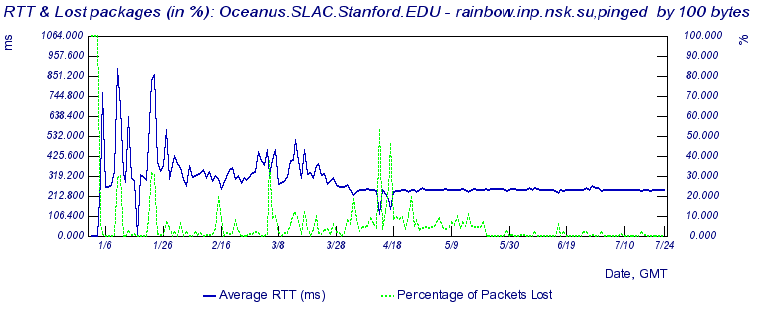Network connectivity between SLAC and BINP, Novosibirsk following upgrade

Les Cottrell.
Page created: July 26 2002.
Central Computer Access | Computer Networking | Network Group | ICFA-NTF Monitoring
|
|
Network connectivity between SLAC and BINP, Novosibirsk following upgrade
Les Cottrell.
Page created: July 26 2002.
|
|
After negotiations between Novosibirsk, KEK/Japan, SLAC and DoE funding was made available to upgrade the link, and on March 24, 2002 the link was upgraded.
1cottrell@antonia:~>traceroute rainbow.inp.nsk.su traceroute to rainbow.inp.nsk.su (193.124.167.29), 30 hops max, 38 byte packets 1 RTR-GSR-TEST (134.79.243.1) 0.228 ms 0.229 ms 0.201 ms 2 RTR-DMZ1-GER (134.79.135.15) 0.304 ms 0.294 ms 0.336 ms 3 SLAC-RT4.ES.NET (192.68.191.146) 0.425 ms 0.409 ms 0.324 ms 4 snv-pos-slac.es.net (134.55.209.1) 1.335 ms 0.711 ms 0.796 ms 5 kek-v4-esnet.es.net (198.129.248.41) 129.739 ms 131.302 ms 130.570 ms 6 kekcis7.kek.jp (130.87.43.7) 132.595 ms 131.808 ms 131.410 ms 7 192.153.114.138 (192.153.114.138) 237.093 ms 237.117 ms 237.290 ms 8 rainbow.inp.nsk.su (193.124.167.29) 238.726 ms * 238.604 msThe round trip time (RTT) and losses on the link for 2002 from SLAC to BINP are shown in the plot below obtained from the SLAC led MICS/DoE funded PingER project. It can be seen that the big variations in RTT (from 250msec to over 800 msec), that are indicative of heavy congestion, disappear after 3/28/02. Also, since the start of 2002, the loss rates have improved from several percent (averaged over an entire month) to less than 0.2 per cent. Losses of several per cent can greatly impede interactive work such as terminal sessions (since the timeouts following a packet loss can make what appears on the screen be several seconds behind what is typed). The derived throughput using the formula
